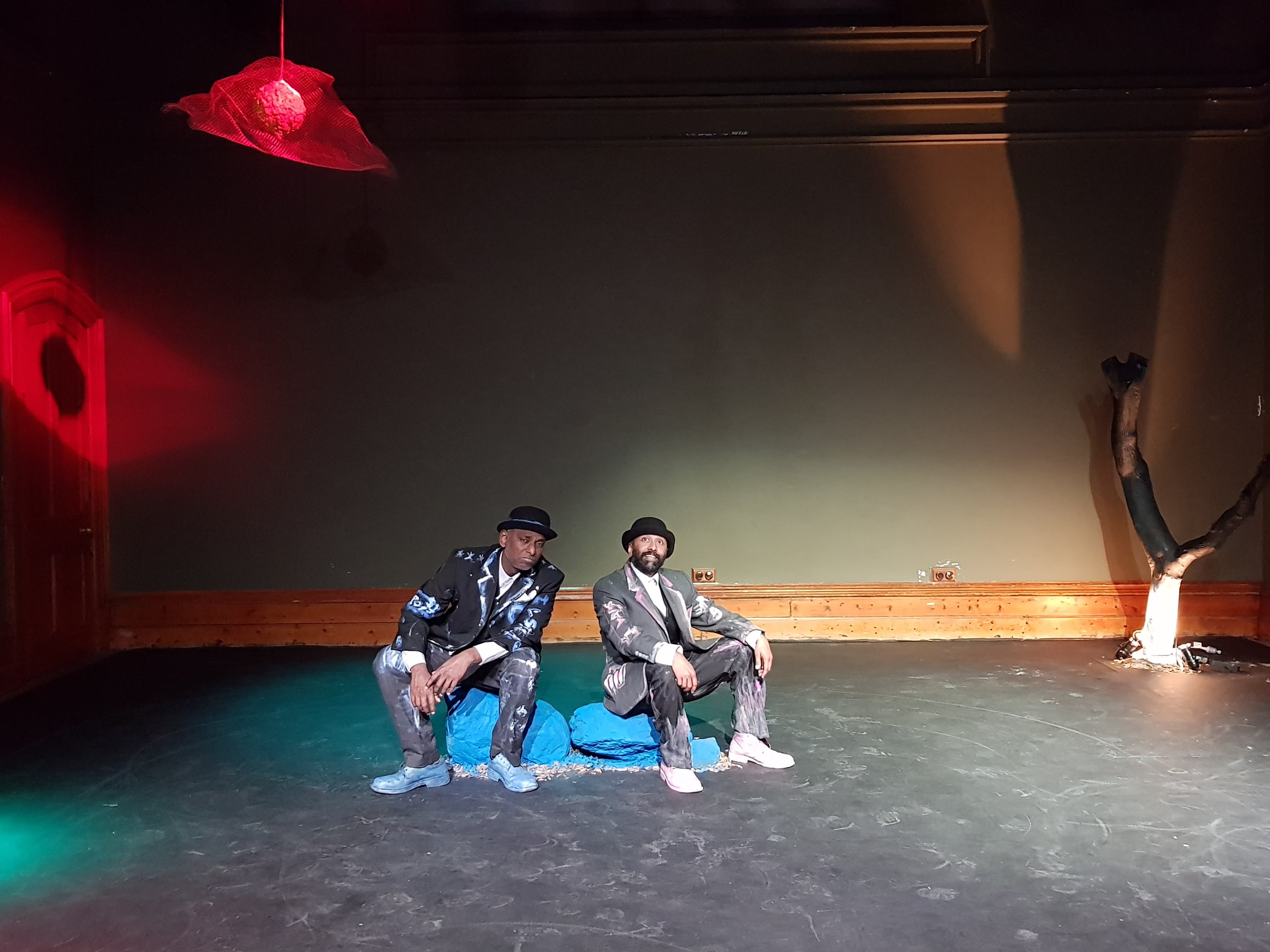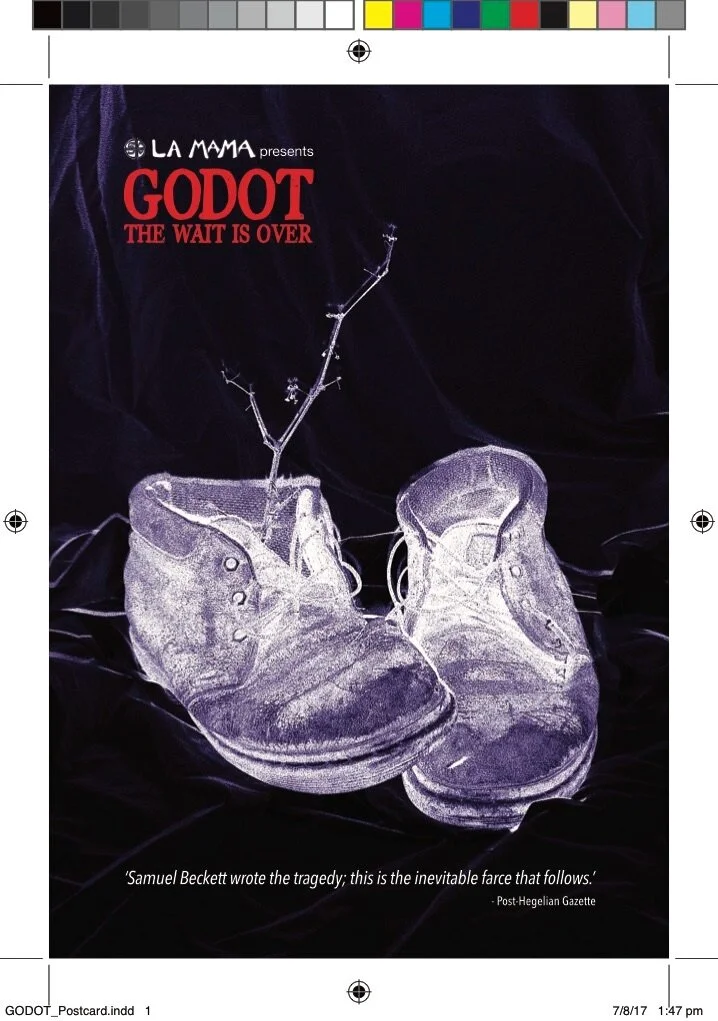“… both a homage to the original and a flight of delicious fantasy away from it … “Oxford Studies in Critical Ambivalence


































September 7th– 17th 2017
La Mama Courthouse, 349 Drummond St, Carlton VIC
Wed 6:00 pm; Thurs – Sat 7:30 pm; Sun 4:00 pm
running time: 105 minutes including interval (15 min)
Poster designed by Lucy Harris
Review - The Lots Wife Magazine
The Players
DIRECTOR: Ezy D
lighting design: Ezy D
Music: Ezy D
Gogo: Cherian Jacob
Didi: Ezekiel Day
Lily and Boy: Suhasini Seelin
Rose : Rebecca Morton
Godot: Rebecca Morton
stage manager: Sebastian, who is Rebecca's Son
photography: Madhulika basu and anyone in between!
poster: Lucy Harris
produced by Cherian Jacob
Godot: The Wait is Over, a play in two acts by Ian Hayward Robinson
A production by Cicero’s Circle Theatre Company
Samuel Beckett’s iconic tragedy Waiting for Godot, has inspired many inconsequential sequels. In Ian Robinson’s Godot: The Wait is Over we finally have a Godot, and a play, worthy of its inspiration. Robinson has managed to recreate the milieu and the rhythms of Beckett’s classic and at the same time magically transform them into a twenty-first century drama. Both a homage to the original and a flight of delicious fantasy away from it, Robinson’s play succeeds in being at once both respectful and irreverant, farcical and serious, physical and cerebral, sad and funny, trivial and meaningful.
No-one, of course, could hope even to come close to equalling the achievement of Samuel Beckett in Waiting for Godot. However, Godot: The Wait is Over is at least a worthy addition to this theatrical tradition and will keep audiences in turn amused, moved, surprised and edified and in the end delighted that they have been on this remarkable journey with the two tramps, Vladamir and Estragon, as they grapple comically with the existential questions of their lives, and finally edge towards a tentative understanding of what it all means.
Brought to you by the people responsible for Ian Robinson’s highly acclaimed 2015 La Mama production The Process, and again starring Ezekial Day, who mesmerised audiences then as the slowly disintegrating refugee, playing alongside producer Cherian Jacob (Sizwe Banzi Is Dead, La Mama, 2014), and joined by Rebecca Morton (Tales of a City by the Sea, La Mama, 2016; Eagles’ Nest Theatre Company) and Suhasini Seelin (Mahabharata of Women; MTC Neon Readings), this is a production that will resonate in your mind long after the theatre’s lights have dimmed.
About the writer
Ian Robinson is a Melbourne writer and editor. His play The Process was performed at La Mama in 2015. He has also worked as an actor at La Mama and The Pram Factory and as a director at La Mama and the University of Melbourne. He was ‘Buckley’ in the cabaret group “Buckley, Hope and Nun”, which performed at The Flying Trapeze and elsewhere. He was the Melbourne Theatre Critic for The National Times for many years. He has also written more than twenty maths textbooks for primary schools and was for a while the President of the Rationalist Society of Australia.
his note on the piece
My relationship with Godot goes back a long way. I first read Waiting for Godot in the early sixties when it was the most important piece of avant garde drama of its era. I didn’t see the first Australia production, starring Barry Humphries, in 1957, which was my matric year at school. But I saw what was possibly the second production, directed by Laurence Beck, as part of the amazing season of Theatre of the Absurd in the Union Theatre mounted by Melbourne University’s Marlowe Society in 1963. This incredible season helped to propel theatre in Melbourne into the modern epoch. Other productions in the Season involved subsequently well-known people such as Germaine Greer, Graham Blundell, Hilary McPhee (later co-founder of McPhee Gribble publishers), Max Gillies, Richard Murphett, Patrick McCaughey and many others. Some time in the sixties I saw a production in the original French by a visiting French company in the Union Theatre, but I am not sure exactly when.
In 1970 I got the chance to act in the play myself, in David Kendall’s MU production, in which I played Pozzo. This was a very Australian reading of the play with the tramps Estragon and Vladimir played as Swaggies, and Pozzo as the local Squatter.
In February 1971 I attended a famous production at the Sheridan Square Playhouse in New York directed by Alan Schneider, who had directed the first American production.
By this time Waiting for Godot was etched in my psyche and as a writer of comedy with a wicked sense of the contrary it was not long before the idea of writing a sequel began to flit around in my brain. But this was not a task to be taken on lightly. You don’t muck around with arguably the most centrally symbolic piece of theatre of the twentieth century. It wasn’t constantly on my mind but I would come back to it from time and I always thought that one day I would have the opportunity to sit down and put all my attention into it.
This opportunity came in 2008 when I had a chance to spend a week alone in former Victorian Arts Minister Mary Delahunty’s Rosebank Farm in Central Victoria, which she had generously made available to arts practitioners as a retreat for projects like mine. The first draft of Act One was written there.
Deciding on the approach and the tone was the big step. I remembered a famous 1852 comment by Karl Marx in The Eighteenth Brumaire of Louis Napoleon: “Hegel remarks somewhere that all great … personages appear, so to speak, twice. He forgot to add: the first time as tragedy, the second time as farce.” Marx and Hegel were, of course, referring to great figures in history, but mightn’t the same principal apply to iconic stage characters? If, in Waiting for Godot, the great Samuel Becket wrote the tragedy, perhaps Godot: The Wait is Over could be the inevitable farce that follows.
Godot: The Wait is Over follows closely the dramatic structure of the original. Each of the two Acts begins with two tramps alone in a wasteland and at the end of each Act they are still there. In between times they talk quietly amongst themselves and entertain a couple of visitors. Towards the end of each Act a Boy arrives with a message from Godot.
But there are two important differences. In Beckett’s play the two visitors are male, which gives the whole play a very masculine ethos. Indeed Beckett always resisted proposals to have all the characters in Waiting for Godot played by women. In Godot: The Wait is Over the two visitors are women. In the twenty-first century we cannot afford to be without the female voice.
The second big change is of course the appearance of the character that the tramps take to be Godot. The message I hope this character embodies is that it’s not easy to be omnipresent, or for that matter, omnipotent and benevolent, all at the same time.
In writing the play over a number of years I had a huge amount of support and encouragement from the wonderful Merle Thornton, whose expert dramaturgical advice has been crucial to the final shape of the play. Moreover, Act Two was written in her house Falmouth Villa in Collingwood which I had the use of for ten days while she was on holiday.
The first draft of this play was given a slightly rehearsed reading by La Mama, Melbourne, at the Carlton Courthouse Theatre, way back in 2009 and I would like to thank the brilliant cast – Robin Cuming, John Flaus, Maggie Millar, Andrea Swifte, Phelix Strangio and Gary Files and director Joy Mitchell, and the audience – for their input and advice.
Finally thanks are due to my friend Sybil Keats who was at that reading and has been constantly asking me ever since if I’ve finalised the script and put it up for production. Without her perseverance, this performance may not have occurred.
But I did complete it and submit it and Cicero’s Circle and La Mama have accepted it for production and I am content. As hopefully is Sybil.







